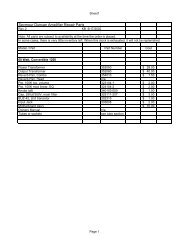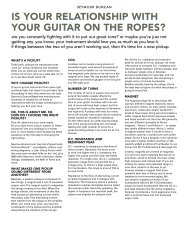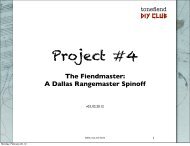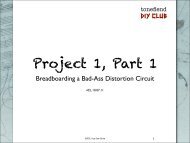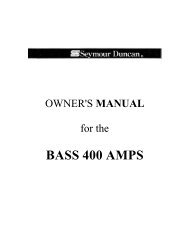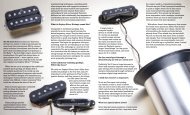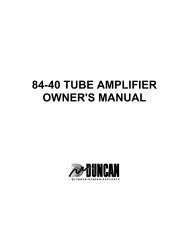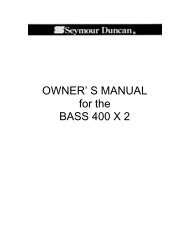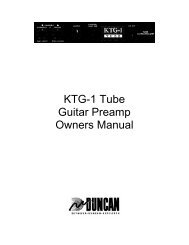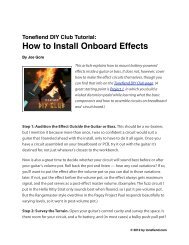Create successful ePaper yourself
Turn your PDF publications into a flip-book with our unique Google optimized e-Paper software.
SEYMOUR DUNCAN RESEARCH<br />
T A R<br />
A<strong>TM</strong><br />
True Acoustic Response <strong>TM</strong><br />
Amplifier<br />
OWNER'S MANUAL<br />
601 Pine Avenue<br />
Santa Barbara, CA 93117<br />
(805) 964-9610<br />
(805) 964-9749 (fax)<br />
©
WARNING: TO REDUCE THE RISK OF FIRE OR ELECTRICAL SHOCK, DO<br />
NOT EXPOSE THIS UNIT TO RAIN OR MOISTURE.<br />
TO REDUCE RISK OF ELECTRICAL SHOCK, DO NOT REMOVE COVER. NO<br />
USER SERVICEABLE PARTS INSIDE. REFER SERVICING TO QUALIFIED<br />
SERVICE PERSONNEL.<br />
TO REDUCE RISK OF FIRE, REPLACE FUSE ONLY WITH SAME TYPE, AS<br />
SPECIFIED.
Introduction<br />
Congratulations on your purchase of the <strong>Seymour</strong> <strong>Duncan</strong> True Acoustic Response <strong>TM</strong><br />
Amplifier. This amplifier has been crafted specifically to fill the needs of the acoustic<br />
guitarist. Every feature has been specifically chosen to give you an unprecedented<br />
amount of control over your sound while allowing the flexibility to handle virtually any<br />
playing situation. It is truly a performance system design.<br />
The cabinet and speaker system were designed to hi-fi standards, providing very flat<br />
transparent sound with an extended bottom end. Each of the two channels will accept<br />
three inputs (Mic, Instrument, & Effects Return) while allowing incredible tone shaping<br />
with two sets of 5-band graphic equalizers and a contour switch. Anti-feedback controls<br />
in both channels have been optimized to allow very high sound pressure levels without<br />
annoying feedback. You can play guitar through one channel, sing through the other,<br />
and mix your drum machine in through one of the three-buffered effects loops. In short,<br />
we think you will find your <strong>TARA</strong> amplifier has the flexibility to handle any playing<br />
situation, from solo club gigs to studio work.<br />
A Discussion on Feedback<br />
An acoustic guitar, which sounds warm, rich and responsive when, played without<br />
amplification can feedback annoyingly when amplified. The sound from the speakers<br />
interacts with the guitar's natural resonance to cause feedback. There are two<br />
dominant resonant sources, the air cavity and the soundboard. The air cavity is the<br />
lower of the two, generally falling around 100Hz. The soundboard, which produces 90%<br />
of the guitar's acoustic output, resonates around 200Hz.<br />
Our T.A.R.A <strong>TM</strong> . amplifier has several features which are designed to control unwanted<br />
feedback. Each channel has a phase switch and a notch filter with variable frequency<br />
and depth. Generally, the phase switch is used to knock out the air cavity resonance of<br />
the guitar and the notch filter is used to control the soundboard resonance. The phase<br />
switch inverts the polarity of the amplifier's output relative to the resonance of the guitar.<br />
Changing the phase of the output signal can effectively control the low frequency air<br />
cavity resonance, although in very loud settings you may actually need to block the<br />
sound hole. The notch filter is very useful in controlling soundboard feedback. Once<br />
the notch filter is "tuned" to your guitar's soundboard, the depth control can be used to<br />
cut more or less depending on how loud you are playing. You only want to notch out<br />
"just enough" to control feedback so that the guitar retains as much of its acoustic<br />
characteristics as possible. Proper use of the phase and notch controls will allow you to<br />
play at high volume levels without feedback and without unduly compromising the<br />
natural timbre of your instrument.
Controls & Features<br />
The <strong>Seymour</strong> <strong>Duncan</strong> T.A.R.A. Acoustic Amplifier has a wide range of very useful<br />
features for getting the best sound out of your acoustic guitar and making the amplifier<br />
extremely versatile in all types of performing and recording applications.<br />
Instrument & Microphone Inputs and Volume Controls - Each channel has an<br />
instrument input and a microphone input. Each input has its own volume control, so<br />
that they can be perfectly balanced in the mix. The microphone input is balanced &<br />
low-impedance, and the instrument input is ultra high-impedance (10Meg). The very<br />
high impedance of the instrument input allows for better impedance matching with<br />
piezo-crystal and piezo-vinyl acoustic pickups, which characteristically have very high<br />
output impedances. When the input impedance of an amplifier is much lower than the<br />
output impedance of the pickup, the pickup may sound very tinny and brittle.<br />
Notch Filter - The notch filter is very useful in combating regenerative feedback (see<br />
section on feedback). It reduces the signal at a particular frequency where the<br />
feedback is occurring (such as your acoustic guitar's sound board resonant frequency).<br />
The notch filter has two controls: notch frequency and depth. The notch frequency<br />
control varies the notch from 50Hz to 500Hz in the left channel (primarily for an acoustic<br />
guitar) and 100Hz to 1kHz in the right channel (primarily for microphones). The depth<br />
knob controls how deep the notch is, up to -25 dB! Turning the knob counter-clockwise<br />
deepens the notch. You should use the depth control to notch out "just enough" of the<br />
feedback frequency to stop the feedback, while preserving the natural timbre and<br />
characteristics of the acoustic guitar. Although most amplifiers do not offer it, the depth<br />
control is essential in maintaining a transparent, flat response.<br />
Phase Reverse Switch - This switch reverses the phase of the amplified guitar signal<br />
coming out of the speaker, relative to the guitar. This can be an extremely helpful<br />
one-shot cure for feedback. Keep in mind that the air-cavity resonance feedback<br />
depends on the distance and direction of the guitar in reference to the amplifier. For<br />
example, if the air-cavity resonance is 100Hz, there will be a feedback-canceling "node"<br />
every 11.2 feet. Halfway between those nodes are the feedback nodes, where it'll be<br />
the worst. Flipping the phase switch changes the feedback nodes into<br />
feedback-canceling nodes and vice versa. Direction of the acoustic guitar in relation to<br />
the speaker will also affect air-cavity resonance feedback, so the best way to keep this<br />
kind of feedback under control is to stay in relatively the same area and facing the same<br />
direction.<br />
Graphic Equalizer - The five-band graphic equalizer has frequency centers placed for<br />
detailed and thorough control of your tone. All the bands are even in bandwidth except<br />
for the lowest band (80Hz), which has been customized with a narrower bandwidth, to
allow the user to boost it for a rich, full sound without boosting the sound board and<br />
air-cavity resonant frequencies (around 200Hz). The 240Hz band is particularly useful<br />
in reducing the frequencies often associated with acoustic guitar feedback.<br />
Master Volume - This potentiometer is the overall output control for the entire amplifier,<br />
and adjusts the volume for all instrument, microphone, and drum-machine inputs.<br />
Peak Indicators - The red peak indicator is a warning that the signal going through the<br />
preamp is very close to clipping, and should light only occasionally. The green LED<br />
indicates that the signal is in the optimal range for the preamp. Running the amp with<br />
insufficient signal level can degrade the signal-to-noise ratio. These indicators monitor<br />
the levels of all the instrument and microphone inputs. When preparing for a<br />
performance, you should go through each instrument and microphone and make sure<br />
the green LED is on most of the time during play and the red LED only lights<br />
occasionally on the loudest notes.<br />
Note: For proper operation, the signal level should be set with the graphic EQ flat.<br />
Effects Loops - The T.A.R.A. amplifier features three effects loops for maximum<br />
versatility. Each channel has its own pre-EQ effects loop so that each can have its own<br />
effect. There is also an overall post-EQ effects loop, which works on both channels. All<br />
of these effects loops are of a professional-quality; "side-chain" type and certain<br />
measures should be taken for optimal sound quality. The mix control on the effects unit<br />
being used should be turned all the way to "wet". The wet/dry mix is then controlled by<br />
the effects mix control on the amplifier itself. This "side-chain" method better preserves<br />
the original dry signal and avoids the degradation of the dry signal, which is unavoidable<br />
with the commonly used "series" type effects loops. With this configuration, the dry<br />
signal is unaffected by the bandwidth and dynamic limitations of the effect unit being<br />
used, so the overall sound is more natural. The -10/+4 dB level switches on the back of<br />
the amp set the effects loop level to match with all types of outboard gear. In general,<br />
the -10dB setting should be used with pedal-type effects & most rack-mount effects, and<br />
the +4dB for pro-studio rack-mount effects. Another use of the "side-chain" effects loop<br />
is the ability to input pre-recorded music, synthesizer, or a drum machine into the overall<br />
mix using the effects return jack. The effect mix control on the amplifier then allows you<br />
to mix in the right amount of the auxiliary input.
Balanced Line Out - This output is for Direct Input into a mixer or recording console.<br />
This output is switchable between pre-EQ and post-EQ signals using the adjacent pushbutton<br />
switch.<br />
Speaker Output(s) - This jack is the speaker output jack for connecting to a speaker<br />
cabinet. For the mono model, this output would normally be connected to the internal<br />
speaker in the cabinet. The amp delivers 75 Watts into 8 ohms and 100 Watts into 4<br />
ohms.<br />
Fuses - The main line fuse is a 5A/250V Slo-Blo for 120V & 100V use, and a 2.5A/250V<br />
Slo-Blo for 220V and 240V use. To reduce risk of fire, replace fuse only with same<br />
type, as specified.<br />
Setting Up for Optimal Performance<br />
A simple step-by-step procedure is outlined below for setting up the amplifier for optimal<br />
performance.<br />
1. Reset Controls - Turn the power on, turn down the instrument input & master<br />
volume, set EQ flat, and turn notch control all the way clockwise (no cut).<br />
2. Set Input Level - Plug guitar into instrument input, and turn up the input volume until<br />
the green LED is on most of the time and the red LED only lights occasionally on the<br />
loudest notes.<br />
3. Set Tone - Turn the master volume up to low listening level and set the EQ &<br />
contour switch to taste.<br />
4. Eliminate Feedback - Mute the strings with your right hand by the bridge. Turn up<br />
the instrument volume until the guitar almost, but not quite, breaks into feedback. Now<br />
tap the soundboard with your finger on your right hand while continuing to mute the<br />
strings, and you should hear a "ping". Set the notch-filter depth control at 12:00. Now<br />
slowly rotate the notch frequency control from about 12:00 to 5:00. At some point the<br />
"ping" should disappear and you'll just hear a dull "thunk" every time you tap the top.<br />
Now the notch filter is tuned to the soundboard resonance of your guitar. Now bring the<br />
master volume up to playing volume. If you get a low rumble or roar when you try to<br />
turn up, push the phase button next to the graphic EQ on the channel you're using, to<br />
cancel the air cavity resonance. The correct phase depends on the position and
direction of the instrument, so make sure you check the phase in the location where<br />
you'll actually be playing, with reference to the amplifier. You'll also find that the louder<br />
you turn up, the deeper you'll have to notch out the sound board resonance using the<br />
depth control.<br />
Specifications<br />
Power Output: 100Watts into 4 ohms.<br />
Output Type: Quasi-complimentary Bipolar.<br />
Power Amp Signal-to-Noise Ratio: >100dB.<br />
Power Amp Sensitivity for Full Power: 0.8V.<br />
Instrument Input Impedance: 10 Megohms.<br />
Microphone Inputs: Low-Z balanced.<br />
Notch Filter Frequency:<br />
Ch.1: 50 - 500Hz.<br />
Ch.2: 100 - 1kHz.<br />
Notch Filter Cut: 0 - 25dB cut.<br />
Dual 5-Band Graphic EQ Frequencies: 80Hz, 240Hz, 720Hz, 2.2kHz, 6.5kHz.<br />
Graphic EQ Operation: + 12dB.<br />
Effects Loops:<br />
2 Pre-EQ, 1 Post-EQ.<br />
Switchable drive/return level: +4dB / -10dB.<br />
Wet/Dry mixing with separate blend controls for each loop.<br />
Line Out: Electronically balanced, capable of driving 600ohm load, switchable pre/post<br />
EQ.<br />
Contour Switch: Enhances sound of piezo-ceramic saddle-type pickups.<br />
Output Protection Fuses: 4 Amp Fast blow (5 x 20mm)<br />
Voltage Requirements:<br />
100V - Japan<br />
120V - U.S., Canada<br />
220V - Europe<br />
240V - U.K.<br />
Weight:<br />
Mono - 52 lbs<br />
Stereo - 53 lbs plus 35 lbs for the additional cabinet<br />
Head - 15 lbs-mono, 16 lbs-stereo<br />
Dimensions:<br />
Mono - 20-5/8"W x 18-3/4"H x 13-3/8" D<br />
Stereo - 20-5/8"W x 18-3/4"H x 13-3/8" D x two
Warranty Information<br />
FOR YOUR RECORDS:<br />
SERIAL NUMBER ___________________ DATE OF PURCHASE _______________<br />
DEALER______________________________________________________________<br />
KEEP YOUR BILL OF SALE IN A SAFE PLACE.<br />
Please read carefully:<br />
<strong>Seymour</strong> <strong>Duncan</strong> amplifiers (hereinafter referred to as the Product) are warranted<br />
against defects in workmanship and materials, excluding tubes and speakers covered<br />
separately, for a period of one year from date of purchase by the original purchaser.<br />
Tubes and speakers are warranted for 90 days from date of purchase. Speaker<br />
warranty will be subject to inspection by the <strong>Seymour</strong> <strong>Duncan</strong> Factory. Obvious<br />
over-powering or abuse will result in warranty denial. This warranty is transferable.<br />
Defective parts will be repaired or replaced without charge if the product is returned to a<br />
<strong>Seymour</strong> <strong>Duncan</strong> Authorized Service Center. In the event a product is to be returned to<br />
the <strong>Seymour</strong> <strong>Duncan</strong> Factory for repairs, A RETURN AUTHORIZATION MUST BE<br />
OBTAINED PRIOR TO SHIPPING BY CALLING OR WRITING THE COMPANY FOR<br />
THE RA NUMBER.<br />
When returning, make certain to include a copy of the bill of sale and a detailed<br />
description of the problem. Any product shipped must be returned in the ORIGINAL<br />
SHIPPING CONTAINER WITH ORIGINAL PACKING MATERIAL and freight prepaid.<br />
Transportation charges involved in warranty service are the sole responsibility of the<br />
owner.<br />
This warranty does not apply to damage caused by misuse, mishandling, negligence in<br />
use or maintenance or storage, and is voided if repairs or adjustments are made after<br />
purchase by anyone other than the <strong>Seymour</strong> <strong>Duncan</strong> Factory or a <strong>Seymour</strong> <strong>Duncan</strong><br />
Authorized Service Center. <strong>Seymour</strong> <strong>Duncan</strong> reserves the right to be the sole judge as<br />
to the misuse or abuse of the product.<br />
The company assumes no liability for incidental or consequential damages which may<br />
result from the failure of this product. Any warranties implied by law are limited to the<br />
duration of this express limited warranty.<br />
Some states do not allow limitations on how long an implied warranty lasts or the<br />
exclusion or limitation on incidental or consequential damages, so the above limitations<br />
may not apply to you. This warranty gives you specific legal rights, and you may also<br />
have other rights, which vary from state to state.<br />
Please return the enclosed warranty card so that we can give you the best warranty<br />
service possible.




